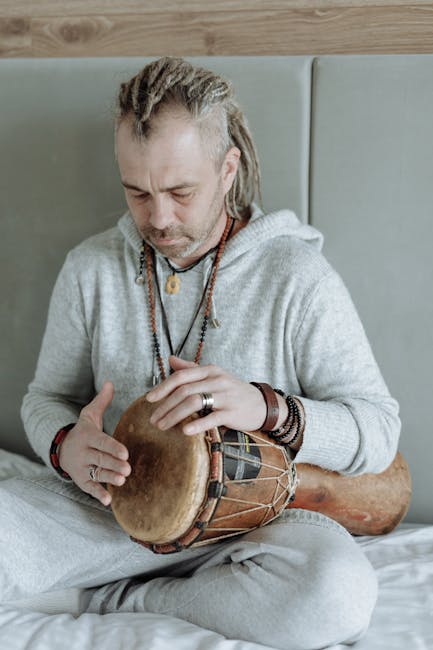Hi everybody! I'm here in the big hall of the Philharmonie Luxembourg and we just had our first rehearsal for the concert on
Friday with the Orchestre Philharmonique de Luxembourg. We will play this wonderful piece by Kalevi Aho, a Finnish composer. It's called Sieidi. Concerto for solo percussion Orchestra.
Composed in 2010. It's a forty minutes piece and I want to show you some
details of this piece and hope I will see you on Friday 7 p.m. here in the big hall. So it starts with the djembe. That's very important
because it's a kind of a journey across the stage. So I start here on the
djembe, it goes on over the whole stage to the tam tam on the other side of
the stage and I'll come back playing again at the end on the djembe.
So the big start is the djembe and the two bass drum players from the orchestra. Fantastic
musicians! So they play on each side of the stage with me in the beginning. It's
like… At the latest after these two bars I
guess everybody will be awake. And it goes on and goes on for let's say two
minutes. It's a trio for the two bass drum players and me as the soloist on the djembe. After the djembe, it starts on the tarabuka. So we had the djembe from Africa and now from the Arabic countries this tarabuka, played with three different sounds. So the bass sound, in the middle. The slap sound. And the very high sound here with the finger.
And this is the music for it. So it looks a
little bit complicated but it's real fun to play this piece and to play this spot
on the tarabuka, together with the percussionists again. They play the
tambourine and then the orchestra, they play this main theme of this very wonderful and very nice piece. So we go on to the set up. So it means five
different tom toms and a marching drum. And now it starts to get really heavy metal. And with the last tom tom here, the double basses start… And now it's getting really dangerous. We go on here on this marching drum. And with the very last note on this marching drum… the two percussionists here, start to play with the big cymbal. And suddenly, the piece is
so different to what we've heard before. After that, we go on with the marimbaphone. A wonderful five octave marimbaphone. And now, you will discover this instrument. The percussion instrument is so different.

Because now it's very sensitive. It's just a cantilène. Then two basses. Conversation with the violin. And it goes on like this. After the bassoons have played the small solo, it goes on here with the very soft sticks on the marimba. And then, maybe one of my favorite parts of this piece starts. A conversation and a duo with the clarinet, marimba and clarinet. And even softer. A clarinet goes on and then again the marimba. And a very last conversation. And after this it starts to get wild! And it goes on for minutes. And I have to
say, it is one of the most difficult parts here because it's really not so
easy to remember all the notes. I played all by heart but also it's quite intense
for my muscles. After that, that timpani! My good friend Benny starts with this
very very loud and intense key sharp. And my answer is here on the wood bloc. And he again… And I again… And it ends like this. And the orchestra… It's very intense with the bass drums and the whole orchestra plays a very, very nice closing motive.
After that, it starts again to be very sensitive on this very nice instrument, the vibraphone. After this vibraphone part, we go on with the wood bloc in a different way. That's not so easy because it's sometimes very similar. And I have to be quite concentrated for it to play the right notes. Now triplets. Semiquavers. And now I have to go with the triplets. It's fast. And the orchestra… Together with the double basses. And so on. So we rehearsed for 20 minutes now with the percussionists. Tambourine, tambourine, marimba. Difficult! Oh man! It's really difficult but I did quite ok. We go on here with the tom toms. Again, the orchestra plays…. And I play the same on the tom toms. And always louder.
Let's get wild! And the ending. But that's not the real ending. And this is what I really like about this piece because then comes the bolero moment. The soloists in the orchestra, and I just play on the tarabuka a simple groove. And the OPL plays… It's so beautiful because after all this wild stuff it's so relaxing to play this on
the tarabuka. And it ends here again as it started with the djembe. The very ending of the djembe is… And the two percussionist start to play with their rain sticks. It makes… And the composer says it should play al niente, which means less less less… until nobody here in the hall can hear the music. It's… After 40 minutes I feel quite tired but I really enjoy this piece and hope you will be at the Philharmonie Luxembourg on Friday night at 7:00. Hope you enjoyed our short and small journey
through all these instruments and through the piece and see you again. Thanks a
lot, bye-bye!.

